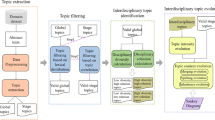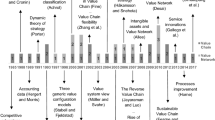Abstract
This study proposes an empirical way for determining probability of network tie formation between network actors. In social network analysis, it is a usual problem that information for determining whether or not a network tie should be formed is missing for some network actors, and thus network can only be partially constructed due to unavailability of information. This methodology proposed in this study is based on network actors’ similarities calculations by Vector-Space Model to calculate how possible network ties can be formed. Also, a threshold value of similarity for deciding whether or not a network tie should be generated is suggested in this study. Four ontology-based knowledge networks, with journal paper or research project as network actors, constructed previously are selected as the targets of this empirical study: (1) Technology Foresight Paper Network: 181 papers and 547 keywords, (2) Regional Innovation System Paper Network: 431 papers and 1165 keywords, (3) Global Sci-Tech Policy Paper Network: 548 papers and 1705 keywords, (4) Taiwan’s Sci-Tech Policy Project Network: 143 research projects and 213 keywords. The four empirical investigations allow a cut-off threshold value calculated by Vector-Space Model to be suggested for deciding the formation of network ties when network linkage information is unavailable.







Similar content being viewed by others
References
Barabasi, A. L., & Albert, R. (1999). Emergence of scaling in random networks. Science, 286(5439), 509–512.
Brass, D. J., & Burkhardt, M. E. (1992). Centrality and power in organizations. In N. Nohria & R. Eccles (Eds.), Networks and organizations: Structure, form and action (pp. 191–215). Boston: Harvard Business School Press.
Callon, M., Courtial, J. P., & Laville, F. (1991). Co-word analysis as a tool for describing the network of interactions between basic and technological research: The case of polymer chemistry. Scientometrics, 22(1), 155–205.
Cambrosio, A., Limoges, C., Courtial, J. P., & Laville, F. (1993). Historical scientometrics? Mapping over 70 years of biological safety research with coword analysis. Scientometrics, 27(2), 119–143.
Cavenago, D., Marafiot, E., Mariani, L., & Trivellato, B. (2009). Network governance and evaluation in public services: A bibliometric literature review. Presented at the conference of the European Group of Public Administration (EGPA), Malta. Retrieved from http://surplus-unibic.cilea.it/oa/handle/10281/8901.
Chandrasekaran, B., Josephson, J. R., & Benjamins, V. R. (1999). What are ontologies, and why do we need them? IEEE Intelligent Systems, 14(1), 20–26.
Clarke, A., Gatineau, M., Thorogood, M., & Wyn-Roberts, N. (2007). Health promotion research literature in Europe 1995–2005. The European Journal of Public Health, 17(Supplement 1), 24–28.
Coulter, N., Monarch, I., & Konda, S. (1998). Software engineering as seen through its research literature: A study in co-word analysis. Journal of the American Society for Information Science, 49(13), 1206–1223.
Freeman, L. C. (1979). Centrality in social networks: Conceptual clarification. Social Networks, 1(3), 215–239.
Granovetter, M. S. (1970). Changing jobs: Channels of mobility information in a suburban community. Unpublished doctoral dissertation, Harvard University, Boston, MA.
Granovetter, M. S. (1973). The strength of weak ties. American Journal of Sociology, 78(6), 1360–1380.
Lee, S. Y., Su, H. N., Lee, P. C., & Chan, T. Y. (2009a). Mapping global science and technology policy research structure. Presented at the 2009 annual conference of the Chinese Society for Management of Technology, Taipei, Taiwan.
Lee, S., Yoon, B., Lee, C., & Park, J. (2009b). Business planning based on technological capabilities: Patent analysis for technology-driven roadmapping. Technological Forecasting & Social Change, 76(6), 769–786.
Liao, L., Xu, K., & Liao, S. S. (2005). Constructing intelligent and open mobile commerce using a semantic web approach. Journal of Information Science, 31(5), 407.
Marsden, P. V., & Campbell, K. E. (1984). Measuring tie strength. Social Forces, 63(2), 482–501.
Marshakova-Shaikevich, I. (2005). Bibliometric maps of field of science. Information Processing and Management, 41(6), 1534–1547.
Motter, A. E., de Moura, A. P. S., Lai, Y. C., & Dasgupta, P. (2002). Topology of the conceptual network of language. Physical Review E, 65, 065102.
National Science Council. (2009). Government research bulletin. Retrieved from http://www.grb.gov.tw.
Neches, R., Fikes, R. E., Finin, T., Gruber, T., Patil, R., et al. (1991). Enabling technology for knowledge sharing. AI Magazine, 12(3), 36.
Nohria, N., Eccles, R. G., & School, H. B. (1992). Networks and organizations: Structure, form, and action. Boston, MA: Harvard Business School Press.
Noyons, E. C. M., & van Raan, A. F. J. (1994). Bibliometric cartography of scientific and technological developments of an R & D field. Scientometrics, 30(1), 157–173.
Noyons, E. C. M., & Van Raan, A. F. J. (1998). Monitoring scientific developments from a dynamic perspective: Self-organized structuring to map neural network research. Journal of the American Society for Information Science, 49(1), 68–81.
Pirró, G., & Talia, D. (2010). UFOme: An ontology mapping system with strategy prediction capabilities. Data & Knowledge Engineering, 69(5), 444–471.
Raghavan, V., & Wong, S. (1986). A critical analysis of the vector space model for information retrieval. Journal of the American Society for Information Science and Technology, 37(5), 279–287.
Rip, A., & Courtial, J. P. (1984). Co-word maps of biotechnology: An example of cognitive scientometrics. Scientometrics, 6(6), 381–400.
Salton, G., & Buckley, C. (1988). Term-weighting approaches in automatic text retrieval* 1. Information Processing & Management, 24(5), 513–523.
Salton, G., & McGill, M. J. (1983). Introduction to modern information retrieval. New York: McGraw Hill.
Salton, G., Wong, A., & Yang, C. S. (1975). A vector space model for automatic indexing. Communications of the ACM, 18(11), 620.
Schildt, H. A., & Mattsson, J. T. (2006). A dense network sub-grouping algorithm for co-citation analysis and its implementation in the software tool Sitkis. Scientometrics, 67(1), 143–163.
Schildt, H. A., Zahra, S. A., & Sillanpaa, A. (2006). Scholarly communities in entrepreneurship research: A co-citation analysis. Entrepreneurship Theory and Practice, 30(3), 399–415.
Sokal, R. R., & Michener, C. D. (1958). A statistical method for evaluating systematic relationships. University of Kansas Science Bulletin, 38, 1409–1438.
Su, H. N., & Lee, P. C. (2009a). Mapping knowledge evolution of technology foresight. Presented at the Academy of Management, Chicago, IL, USA.
Su, H. N., & Lee, P. C. (2009b). Knowledge map of publications in research policy. In Portland international conference on management of engineering & technology, Portland, OR, USA.
Su, H. N., Lee, P. C., Chien, I. C., & Chan, T. Y. (2009). Network perspective of science and technology policy research community in Taiwan. Presented at the 2009 annual conference of the Chinese Society for Management of Technology, Taipei, Taiwan.
Van Raan, A. F. J., & Tijssen, R. J. W. (1993). The neural net of neural network research: An exercise in bibliometric mapping. Scientometrics, 26(1), 169–192.
van Rijsbergen, C. J. (1979). Information retrieval. London: Butterworths.
Wasserman, S., & Galaskiewicz, J. (1994). Advances in social network analysis: Research in the social and behavioral sciences. Newbury Park: Sage.
Watts, D. J. (2003). Six degrees: The science of a connected age. New York: WW Norton & Company.
Watts, D. J., & Strogatz, S. H. (1998). Collective dynamics of ‘small-world’ networks. Nature, 393(6684), 440–442.
Wellman, B., & Berkowitz, S. D. (1988). Introduction: Studying social structures. In B. Wellman & S. D. Berkowitz (Eds.), Social structures: A network approach (pp. 1–14). Cambridge: Cambridge University Press.
Weng, S., & Chang, H. (2008). Using ontology network analysis for research document recommendation. Expert Systems with Applications, 34(3), 1857–1869. doi:10.1016/j.eswa.2007.02.023.
Yoon, B., Lee, S., & Lee, G. (2008). Keyword-based knowledge map of academic research. Presented at the third European conference on management of technology, Nice, France.
Yoon, B., & Park, Y. (2004). A text-mining-based patent network: Analytical tool for high-technology trend. Journal of High Technology Management Research, 15(1), 37–50.
Zhang, Y., Qu, Y., Huang, H., Yang, D., & Zhang, H. (2009). An ontology and peer-to-peer based data and service unified discovery system. Expert Systems with Applications, 36(1), 5436–5444. doi:10.1016/j.eswa.2008.06.083.
Author information
Authors and Affiliations
Corresponding author
Rights and permissions
About this article
Cite this article
Lee, PC., Su, HN. & Chan, TY. Assessment of ontology-based knowledge network formation by Vector-Space Model. Scientometrics 85, 689–703 (2010). https://doi.org/10.1007/s11192-010-0267-8
Received:
Published:
Issue Date:
DOI: https://doi.org/10.1007/s11192-010-0267-8




